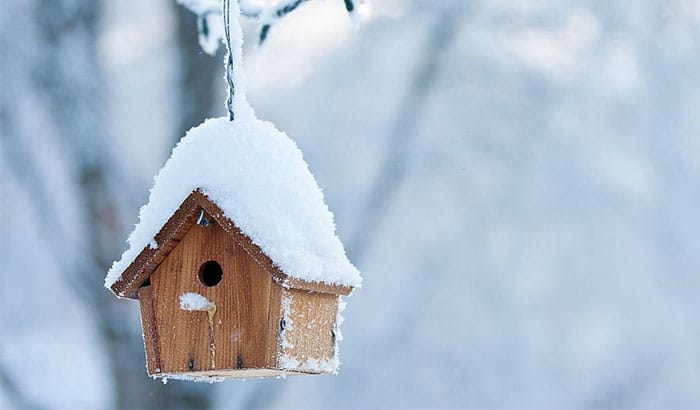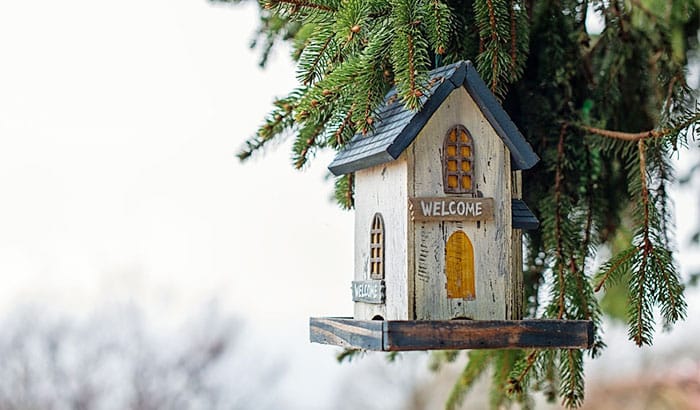Did you know that as many as 30 species of bird in each region of the United States are likely to use a birdhouse? This is why putting up a birdhouse in my backyard is a big deal for me. Aside from adding beauty to my property, a birdhouse allows me to provide a safe haven for small birds and potentially their young. I leave my birdhouses up all year round, even during winter. A few neighbors began to wonder, “Do birds use birdhouses during winter?”
The short answer is, “Yes. Birds use birdhouses during winter.” And there are a few surprising reasons why birds use birdhouses in winter.
Contents
3 Interesting Reasons Why Birds Use Birdhouses in Winter
Not All Birds Migrate for the Winter
Perhaps the reason many people wonder why I leave my birdhouses up even during winter is that they think that birds migrate to warm places. Non-migratory birds, resident birds, or homebodies, live in the same year throughout the entire year.
Some examples of non-migratory birds include:
- Wrens
- Bluebirds
- Chickadees
- Swallows
- Sparrows
- Cardinals
- Magpies
- Jays
A lot of these birds are also known as cavity nesters. The Spruce defines cavity-nesting as “a term that describes birds that build nests, lay eggs and raise young inside sheltered chambers or cavities.”
It is these non-migratory birds that might need birdhouses in winter. During the cold months, they will look for a suitable shelter. Birdhouses are just one of the many suitable shelters for cavity nesters. The Smithsonian even goes as far as saying that birdhouses provide shelter where there are no alternatives.
Birds Need a Place to Roost
Birds roost. Roosting is a period of inactivity similar to human sleep. A lot of cavity nesters roost during the harsh cold months of winter. Finding warm and dry places to roost during winter is critical, especially for smaller birds.
While some birds roost in holes in trees, or underground, others look for unnatural cavities such as the rafters of a barn, pipes, or birdhouses. If a bird occupies a birdhouse during the winter, it is sometimes referred to as a roost box.
Birds have varying roosting habits. Some roost communally, others individually. Roosting during the winter is an effective method to survive the extreme cold. This is yet another reason why non-migratory birds use birdhouses in winter.
Birds Need Shelter for Protection
In the wild, protection is a major asset. Birds need shelter for protection. I noticed that the majority of the non-migratory birds in my area are small and defenseless birds. They wouldn’t survive a week out in the wild without a shelter to protect them from predators.
But aside from predators, these small birds also need protection from bad weather. Birdhouses provide that protection to the birds that occupy them. There are two types of cavity nesters: primary and secondary. Primary cavity nesters excavate or dig their own cavities in trees or the ground annually. Secondary cavity nesters rely on cavities that are already there. These cavities may have been built by primary cavity nesters, or naturally occurring holes in trees, or birdhouses.
Secondary primary nesters then make the cavity as homely as they can. They bring twigs, leaves, or feathers to make something of a nest in it. What has this got to do with birds using birdhouses in winter? Some of these birds make the birdhouse as warm as possible. They may also communally roost in it to share each others’ warmth.
During the winter, birdhouses not only serve as a roosting place for birds. They also serve as a safe haven, a source of protection from the harsh winter cold and predators.
How to Prepare a Birdhouse for Winter Occupancy
To provide the best shelter for birds during winter, I take the following steps:
Cleaning the birdhouse
It’s vital to clean the birdhouse of old nesting materials. Birds have different needs during the summer and the winter. Removing the summer nesting materials before winter makes the birdhouse more appealing. In this process, I also take care to repair any damage to the birdhouse.
Insulate
I want to provide lots of warmth for the occupants of my birdhouse every winter. I make sure to block any unnecessary air holes or cracks in the birdhouse. Ventilation holes necessary during the summer months are detrimental during winter. I want the birds to remain warm and dry as much as possible.
Add perches
Create an environment conducive to communal roosting within the birdhouse. Instead of letting the birds settle on the floor of the house, create perches so there is more room for more birds. The birds can use each others’ body heat to keep themselves warm. Twigs and a few dowels can go a long way for these animals.
Beware of predators
It’s still important to use baffles or predator guards around the birdhouse during winter. It is the season of the year when birds like to flock together to use their collective body heat. If a predator gets into the birdhouse, a lot of birds may die. I find it useful to place the birdhouse somewhere predators can’t easily reach it. I place it high from the ground but impossible for climbing predators to reach.
Final Thoughts
Birdwatching never stops. Just because the spring and summer nesting months are over, it doesn’t mean that I can’t enjoy the sight of birds in my backyard. By providing a shelter conducive to their comfort and security, I get to have an abundance of birds to see throughout the bleak winter months.


